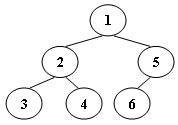PTA-Tree Traversals Again
题目描述
An inorder binary tree traversal can be implemented in a non-recursive way with a stack. For example, suppose that when a 6-node binary tree (with the keys numbered from 1 to 6) is traversed, the stack operations are: push(1); push(2); push(3); pop(); pop(); push(4); pop(); pop(); push(5); push(6); pop(); pop(). Then a unique binary tree (shown in Figure 1) can be generated from this sequence of operations. Your task is to give the postorder traversal sequence of this tree.

Input Specification:
Each input file contains one test case. For each case, the first line contains a positive integer N (≤30) which is the total number of nodes in a tree (and hence the nodes are numbered from 1 to N). Then 2N lines follow, each describes a stack operation in the format: “Push X” where X is the index of the node being pushed onto the stack; or “Pop” meaning to pop one node from the stack.
Output Specification:
For each test case, print the postorder traversal sequence of the corresponding tree in one line. A solution is guaranteed to exist. All the numbers must be separated by exactly one space, and there must be no extra space at the end of the line.
Sample Input:
6
Push 1
Push 2
Push 3
Pop
Pop
Push 4
Pop
Pop
Push 5
Push 6
Pop
Pop
Sample Output:
3 4 2 6 5 1
分析
- 题目中给出的出栈序列是中序遍历,而入栈的序列是先序遍历的序列,要求的是后序遍历的序列
- 根据树的重构的知识( https://blog.csdn.net/zhanw15/article/details/80619738 ),我们可以用先序遍历和中序遍历重构出整个二叉树,然后再进行后序遍历
- 重构的思路:使用递归,用一个队列存储先序遍历,该队列的首元素即为中序遍历的根节点,然后在中序遍历啊中找到这个元素,该元素左边是它的左子树,右边是右子树
代码
1 |
|